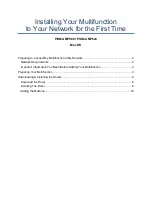
XEROX WorkCentre 7755/7765/7775 Information Assurance Disclosure Paper
22
Ver. 1.01, April 2010
Page
22 of 40
3.3.
System Accounts
3.3.1.
Printing [Multifunction models only]
The device may be set up to connect to a print queue maintained on a remote print server. The login name and password
are sent to the print server in clear text. IPSec should be used to secure this channel.
3.3.2.
Network Scanning [Multifunction models only]
Network Scanning may require the device to log into a server. The instances where the device logs into a
server are detailed in the following table. Users may also need to authenticate for scanning. This
authentication is detailed in subsequent sections.
3.3.2.1.
Device log on
Scanning feature
Device behavior
Scan to File, Public Template
The device logs in to the scan repository as set up by the SA in User
Tools.
Scan to E-mail, I-Fax
The device logs into an LDAP Server as set up by the SA in User
Tools. It will only log into the Server when a user attempts to use
the scan-to-email feature. At the time the LDAP server must be
accessed, the device will log into the LDAP server.
The device uses simple authentication on the LDAP server. A network
username and password must be assigned to the device. The device
logs in as a normal user, with read only privileges. User credentials are
not used for this authentication step, and are never transmitted over the
network.
Scan to Fax Server
The device logs in to the Fax Server as set up by the SA in User Tools on
the Local UI or from the Properties tab on the WebUI.
Please note that when the device logs into any server the device username and password are sent over the
network in clear text unless SSL has been enabled or IPSec has been configured to encrypt the traffic.
3.3.2.2.
Scan Template Management
This is a web service that allows the SA to manage templates stored in a remote template pool. The connection
to the remote pool can be secured with SSL.
3.4.
Diagnostics
3.4.1.
Service [All product configurations]
To access onboard diagnostics from the local user interface, Xerox service representatives must enter a
unique 4-digit password. This PIN is the same for all product configurations and cannot be changed.
For additional security, a Xerox authorized service representative can enable a “secure diagnostics” mode.
In this mode, the service representative must enter two PINs to access onboard diagnostics. When enabling
the secure diagnostics mode for the first time, the service representative should change the PIN to
something known only to him or his local team. On subsequent logins, the secure diagnostics PIN must be
entered followed by the standard diagnostics PIN in order to gain access to the diagnostics menu.
















































